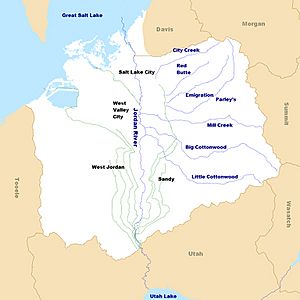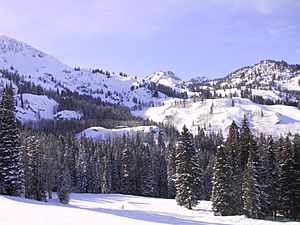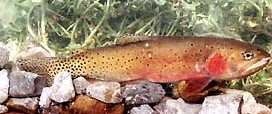Big Cottonwood Creek facts for kids
Quick facts for kids Big Cottonwood Creek |
|
|---|---|

Big Cottonwood Creek near Big Cottonwood Park
|
|

Little Cottonwood Creek and other Salt Lake County streams
|
|
| Country | United States |
| State | Utah |
| Physical characteristics | |
| Main source | Brighton, Utah, Salt Lake County, Utah 9,600 ft (2,900 m) 40°36′0″N 111°35′0″W / 40.60000°N 111.58333°W |
| River mouth | Jordan River Murray, Utah, Salt Lake County, Utah 4,250 ft (1,300 m) 40°40′47″N 111°54′42″W / 40.67972°N 111.91167°W |
| Length | 26 mi (42 km) |
| Basin features | |
| Basin size | 43 sq mi (110 km2) |
Big Cottonwood Creek is a big stream that flows into the Salt Lake Valley from the east. It starts high up in the Wasatch Mountains. The creek travels through Big Cottonwood Canyon for about 18 miles (29 km). It then flows through towns like Cottonwood Heights, Holladay, and Murray, Utah. Finally, it joins the Jordan River about 5 miles (8 km) south of Salt Lake City. In the summer, all its water is used to help grow crops. The creek is about 26 miles (42 km) long from where it starts to where it meets the Jordan River.
Where Does the Water Come From?
Big Cottonwood Creek starts at a high elevation of about 9,600 feet (2,926 meters). It flows down to about 4,250 feet (1,295 meters) where it meets the Jordan River. The stream begins near the Brighton Ski Resort. It flows northwest at first, then southwest, and then northwest again.
The water comes from several lakes at the top of the canyon. These include Silver Lake, Twin Lakes Reservoir, Lake Mary, Lake Martha, Lake Catherine, and Dog Lake. Rain and many smaller streams also add water to Big Cottonwood Creek. Brighton gets a lot of rain and snow each year. About 400 inches (1,016 cm) of snow falls annually.
This canyon is a special protected area. It is a major source of drinking water for Salt Lake City. Because of this, there are strict rules. For example, dogs and horses are not allowed in the watershed. The water quality is excellent for drinking.
Fun Things to Do in the Canyon
Big Cottonwood Canyon is a great place for outdoor activities. You can go fishing, hiking, and camping. Many people also enjoy picnicking and sightseeing. In the winter, skiing and snowboarding are very popular.
The land in the canyon is a mix of public and private areas. There are many homes along Big Cottonwood Creek. Two large ski resorts are also located here. All these activities mean people need to help protect this special place.
Fish in the Creek
Big Cottonwood Creek is home to several types of trout. You can find rainbow trout, brook trout, and brown trout. The native Bonneville cutthroat trout also lives here. The Utah Division of Wildlife Resources adds rainbow trout to the creek every year.
This creek is known as a "Class II Fishery." This means it is a good place for fishing and other fun activities. It's especially important because it has many trout and is close to a big city.



